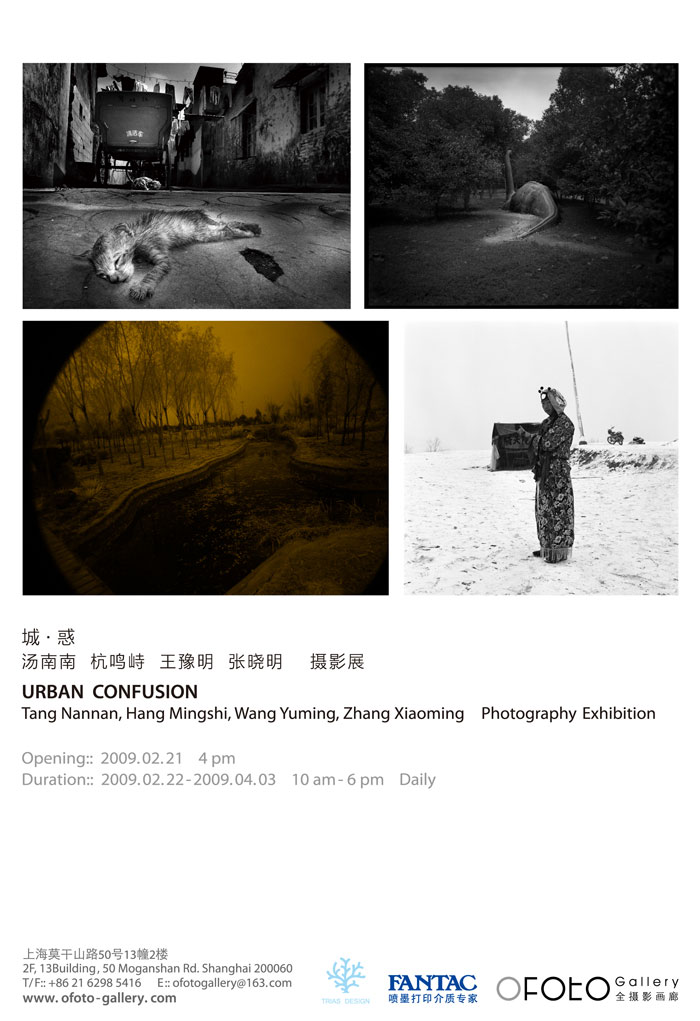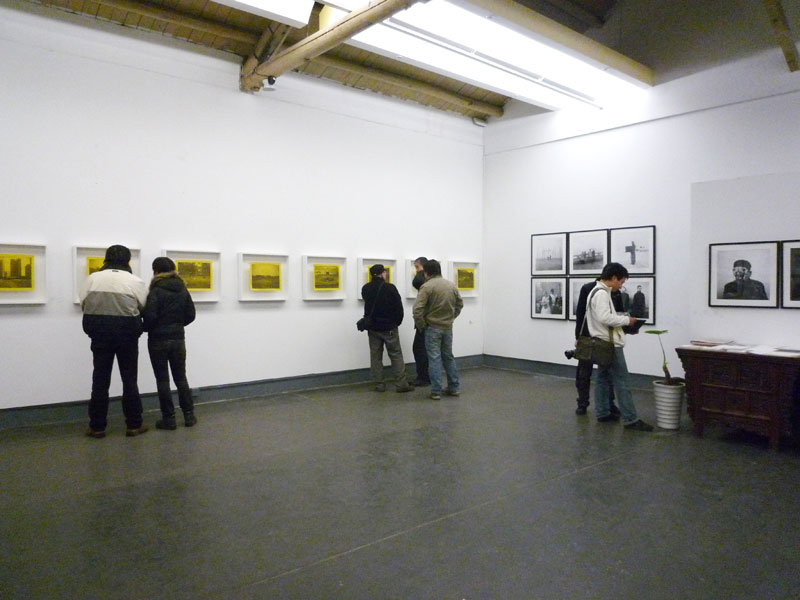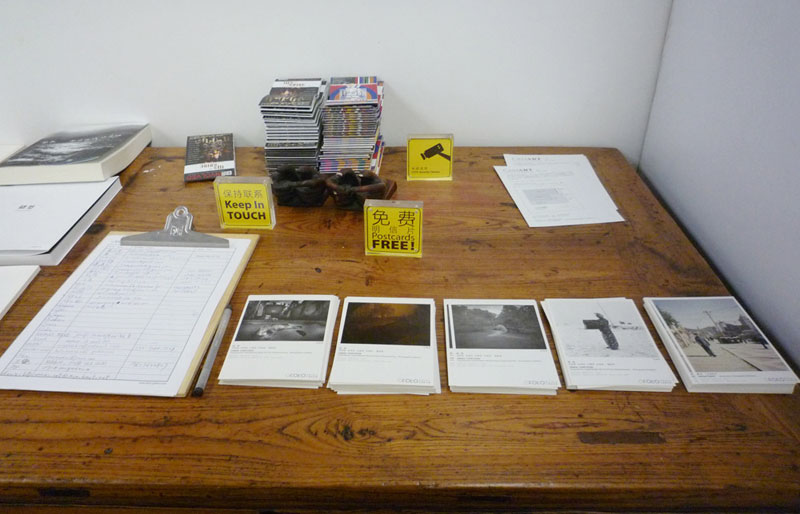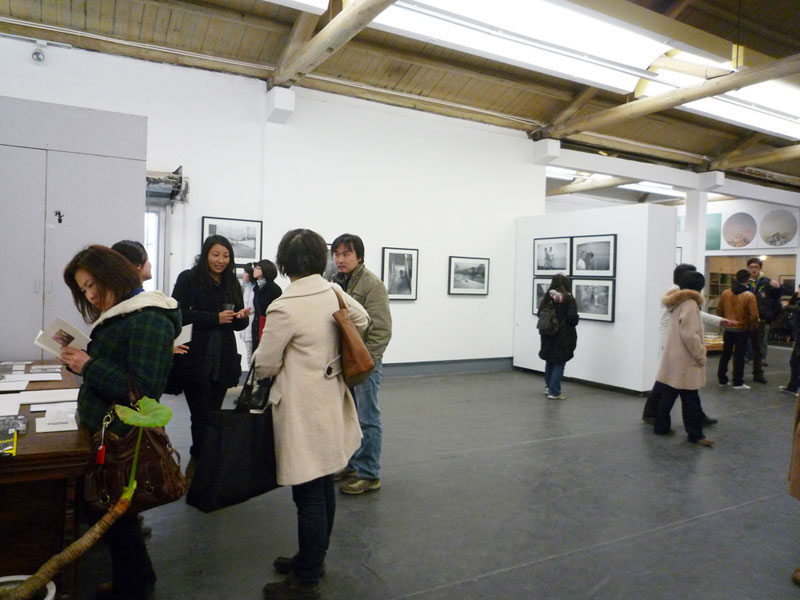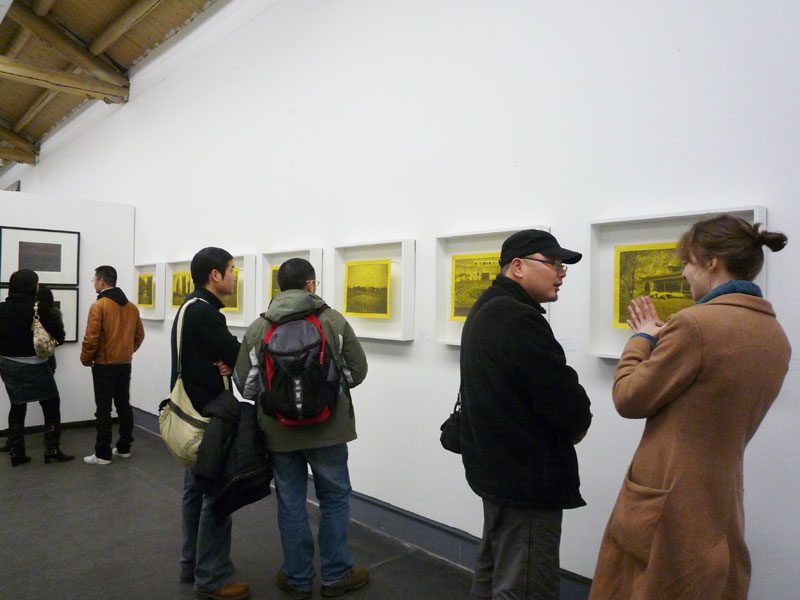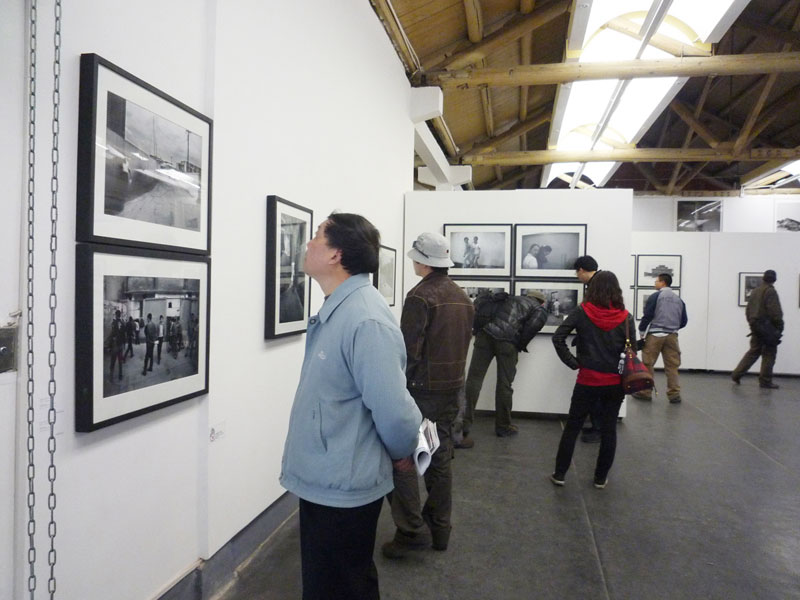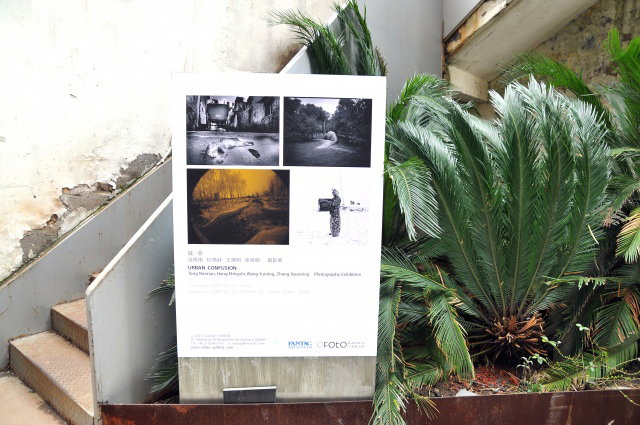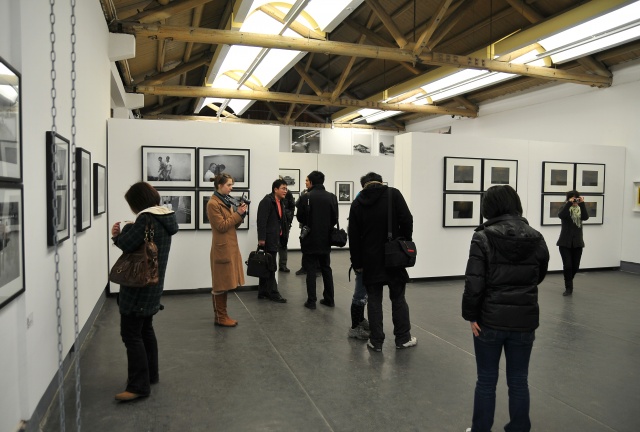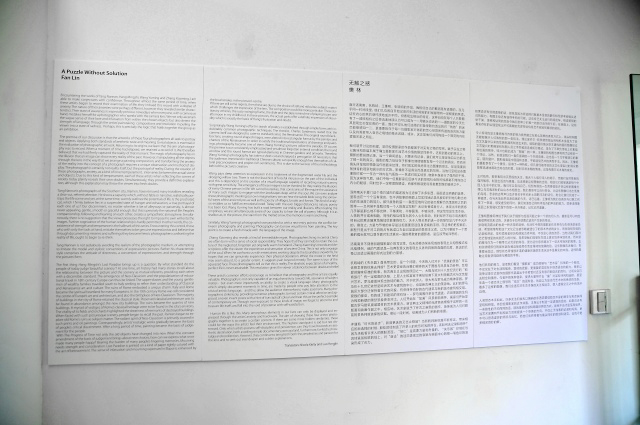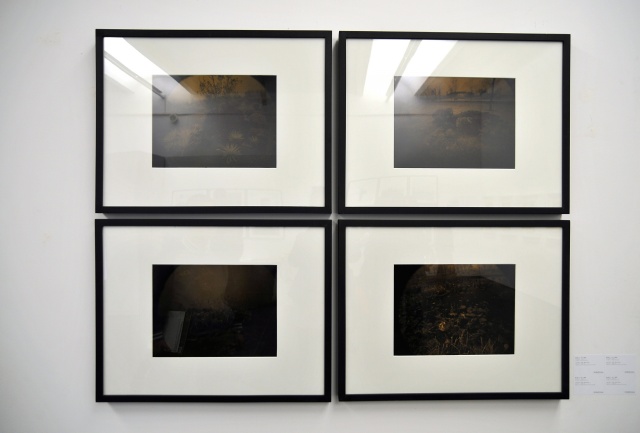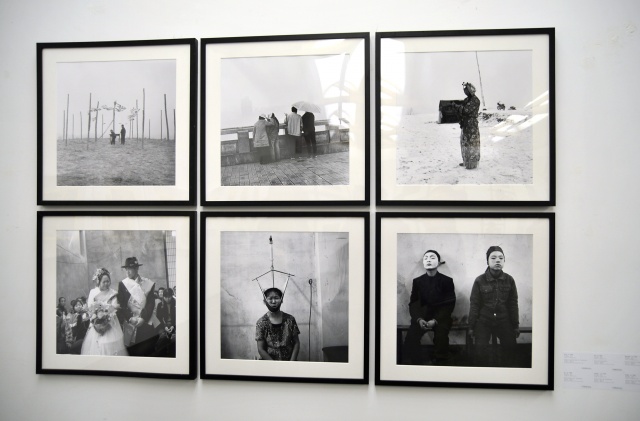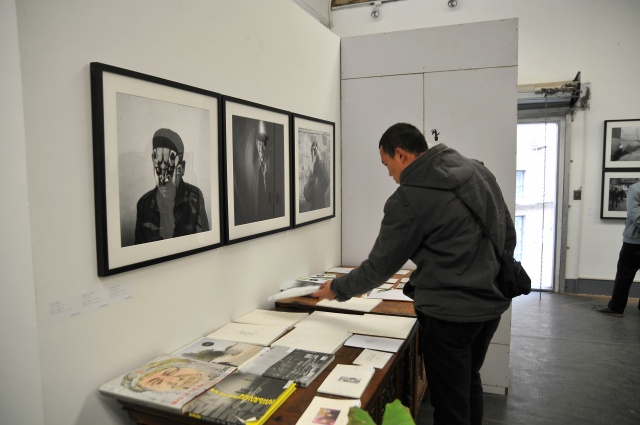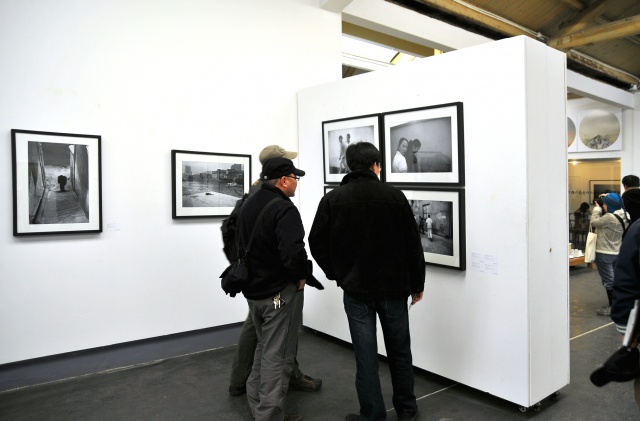A Puzzle Without Solution
by Fan Lin
Encountering the works of Tang Nannan, Hang Mingshi, Wang Yuming and Zhang Xiaoming, I am able to make conjectures with confidence. Throughout almost the same period of time, when these artists began to record their examination of life, they imbued this record with a degree of anxiety. The nature of their anxieties were perhaps different, however they revealed similar characteristics. Their state of awareness is especially precious nowadays when everyone, with a camera at hand, mistakes himself for a photographer who ‘speaks’ with the camera lens. We not only ascertain the vague sense of their love and infatuation from within the chosen objects but also detect the strength of language through the artists’ painstaking compositions and resolution in pulling the viewer into a state of sadness. Perhaps, this is precisely the logic that holds together the group as an exhibition.
The premise of our discussion is that the artworks of these four photographers all seek to portray real objects. Applying both standards of aesthetic taste and meaning to real objects is essential in the evaluation of photographic artwork. Returning to its origins, we learn that the aim of photography was to record. When a moment of time had elapsed, we retained a record of it. We therefore believed that we had firmly captured the reality of that moment. The magic of photography lies in the illusion that an image can show every reality of the past. However, manipulating all the objects through the lens in the way that we arrange a painting composition, and transforming the anxiety of the reality into the concept of a photograph requires a unique observation and method of display. The photograph is certainly not reality itself, but the portrayal of reality. During the creation of these photographs, anxiety, as a kind of inner temperament, intervenes between the actual scene and objects. Due to this kind of temperament, each of these artists when reflecting the scenes of society today plainly reveals their own doubts. Simultaneously, they provide a definitive explanation, although this explanation may throw the viewer into fresh doubts.
Tang Nannan’s photographs of the Southern city, Xiamen, have removed many trivialities revealing a clear-cut, refined selection. He shows a capacity which, without fable or narrative, realistically portrays the life scene and yet, at the same time, warmly outlines the potentials of life. Is the prostrated cat, which I firmly believe lies in a suspended state of hunger and exhaustion, a true portrayal of each one of us? Our discernment, no matter whether it be of alleyways or passersby, is almost never appealing, gentle, smooth or graceful enough. But this is precisely the nature of life. People’s companionship, following and leaning on each other, creates a sympathetic atmosphere. Simultaneously, there is no suggestion that the viewer possesses the right to impose his own will onto the images. Further cognizance of the human relationship is hardly permitted. In other words, the co-existence of strength and temperance is the hallmark of this series. Encountering this control, those who with only the tools at hand, mistake themselves to be genuine expressionists and believe that through documenting miseries and sufferings they become heroic photographers confronting the reality of life, ought to begin to re-think.
Tang Nannan is not sedulously avoiding the realism of the photographic medium, or attempting to imitate the modal and stylistic conventions of expressionist pictures. Rather his characteristic style comprises the attitude of directness, a convention of expressionism, and strength through the pictures’ form.
The first thing Hang Mingshi’s Lost Paradise brings up is a question: By what standard do the people of today judge ‘beautiful scenery’? At one time, art history had many stories to tell about the relationship between the picture and the scenery as mutual referents, providing each other with a discernible standard. The emergence of Neo-Classicism and the popularization of educational travel in 18th century Europe can thus be linked. The upper-classes and the young gentlemen of wealthy families travelled south to Italy seeking to refine their understanding of Classical and Renaissance art and culture. The ruins of Rome embodied a unique charm. Italy and Rome became the spiritual heartland for many Europeans. In the 19th century Rome was still considered the centre of Europe’s art and architecture, and also the birthplace of Neo-Classicism. The majority of buildings in the city of Rome retained the classical style. Preserved classical architecture was to be found in abundance amongst the new city buildings. The ruins became the quarries of new buildings. A myriad of vestiges of Rome’s classical heritage were to be found in the city’s environs. The vitality of its fields and orchards highlighted the dreariness of remnants of destroyed buildings. When faced with such picturesque scenery, people began to recall the past. Painters began to explore old Rome’s ruins as subject-matter. The radiant spirit of Neo-Classicism is primarily sourced in such prints and oil paintings. Correspondingly, artists’ nostalgic works gradually became the basis of people’s critical discernment. After a long period of time, painting became the basis of judgement for the people.
With The Progress of Time not only the old objects have changed into new. When the constant amendment of the basis of judgement brings about new choices, how can we express what once made many people happy? Bearing the burden of many people’s lingering memories, Mourning needs strength and consideration. Lost Paradise is printed on a kind of paper tightly sutured with the act of bereavement. The sense of infatuation and mourning expressed in Elapse is enhanced by the brushstrokes in the picture’s centre.
If there are still some regrets, then these are due to the choice of still and ridiculous subject-matter which challenges the expression of the lens. The composition could be more particular. These stationary vehicles, the rusty swinging frame, the slide and the pipe remind me of playing truant one afternoon in my childhood. In these pictures, the actual parks offer a definite impression of obsurdity which is exactly the basis of Hang’s frustration and doubt.
Surprisingly, Wang Yuming’s effort in search of poetry is established through simple forms with indubitably common photographic techniques. The theorist, Charles Sanderson, stated that the camera itself was designed to cater to standards since the Renaissance. The original round black-box lens, creating round-shaped images, were altered into rectangular format by the painters and charters of the Renaissance. In order to satisfy the traditional expectations of drawings and paintings, photography became one of them. Wang Yuming’s pictures utilize this paradox. Of course, the premise is our consistently emphasized and yet almost forgotten external condition; the round window and the round format are typical elements in Chinese gardens and artworks. Therefore, Wang Yuming’s photography has taken a short-cut and enjoyed a prerogative. Of necessity is that the audience, immersed in traditional Chinese culture, can quickly enough free themselves of cultural preconceptions and project rich sentiments. This is due to the success of the methodology behind the picture’s creation.
Wang pays deep attention to expression in his treatment of the fragmented water lily and the drooping willow tree. There is not the least hint of forceful intrusion on the part of the individual and this is dependent on his creation of a visual language capable of recording natural scenery with great sensitivity. The emergence of these images is to be thanked, for they realize the illusions of every Chinese person in life. We can tell ourselves, that constraints of life require the assistance of many such images to engage with the landscapes deep within the soul. We can even analyze these photographs invoking our own imaginations; we can hear the subtle birds’ song, the sorrowful tones of the ancient lyres as well as the poetry of villages, brooks and forests. This kind of analysis enables us to fulfill an emotional need. Today with the ever bigger distance to nature, poetry has been lost. Wang Yuming has built a road between our reality and illusions. When feeling the emptiness, we are simultaneously aware of our capacity to hear the call of poetry. Although it is as shallow as, in the picture, the stain from the melted snow, the memory is warm and living.
Similarly, Wang Yuming’s photographs have provided us with a new entry point to the conflict between photography and painting: Photography can borrow visual forms from painting. The key point is to create a fresh miracle with the language of the image.
Zhang Xiaoming also reveals a kind of irremediable regret. Photographers living in central China are often born with a sense of social responsibility. They hope that they can help to retain the culture of the neglected, forgotten yet originally warm homeland. Zhang Xiaoming’s records and descriptions offer the viewer the experience and sensation of ancient China. This is not only a voyage of the soul. When he confronts us with entertainers working despite the boundless snowdrifts, he hopes that we can genuinely experience their physical desolation. Whilst the motor in the field may seem absurd, to a greater extent, it suggests pain beyond remedy. The same is true of the squeezed face. These photographs tell us that this is reality. The idealistic expectation of a healthy, perfect life is never attainable. This resolution gives the viewer a balance between doubt and relief.
These artist’s common efforts encourage us to believe that photography and fine art are equally valuable. Photography is not only capable of an equal sensitivity towards life, assurance of subject matter,but even more importantly an ability to create a visual language. Many photographs which simply document moments in time, are made by people who pay little attention to the crisis of artistic language,and thus allow the audience themselves to make assertions. Many photographers strike lucky, providing numerous photographs to meet certain critical selection and approval, or even invent poses with a hint of ‘conceptual’ colour and treat this as the perfect example of contemporary art. Through over-exposure to these kinds of image, we forget to attend to and treasure life itself, and fall into the void of pretense with self-satisfaction.
Human life is like this. Many amorphous elements in our lives can only be displayed and expressed through the artists’ anxiety and hard-work. The aim of showing these four artists’ photographs together is to create a certain content. If there are some more hidden similarities, these could be the ways the artists’ feel their environment. The highest standpoint is sad but not distressed. Only when artists possess self-discipline and persistence, can they travel towards an aesthetic destination, both avoiding simple documentary portrayal and, furthermore, far-fetched nostalgia and recollection. However, they continue to bring forth both the perplexities and passion for the lens and to seek out ever deeper and subtler explanations.
Translators: Nicola Kielty and Luo Yongjin
翻译:Nicola Kielty、罗永进
